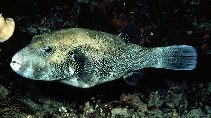| Family: |
Tetraodontidae (Puffers), subfamily: Tetraodontinae |
| Max. size: |
80 cm TL (male/unsexed) |
| Environment: |
reef-associated; marine; depth range 2 - 50 m |
| Distribution: |
Indo-West Pacific: Reunion and Maldives, eastward through Indonesia and Papua New Guinea to the Coral Sea, and northward to Japan. |
| Diagnosis: |
Dorsal soft rays (total): 11-12; Anal soft rays: 10-12. Description: Characterized by yellowish brown color on back and side grading to white on belly; presence of alternating light and dark rings around eye; pectoral fin base with black patch with white spots; head, body and median fins with small blue spots; head and body with spinules except posterior caudal peduncle, around eye, gill opening and base of dorsal and anal fins; bony interorbital width 2.4-2.9 in head length; rounded caudal fin, length 4.0-5.0 in SL (Ref. 90102). |
| Biology: |
Found primarily in coral reefs. Also occurs in temperate waters. Solitary (Ref. 90102). |
| IUCN Red List Status: |
Least Concern (LC); Date assessed: 07 June 2011 Ref. (130435)
|
| Threat to humans: |
poisonous to eat |
Source and more info: www.fishbase.org. For personal, classroom, and other internal use only. Not for publication.
